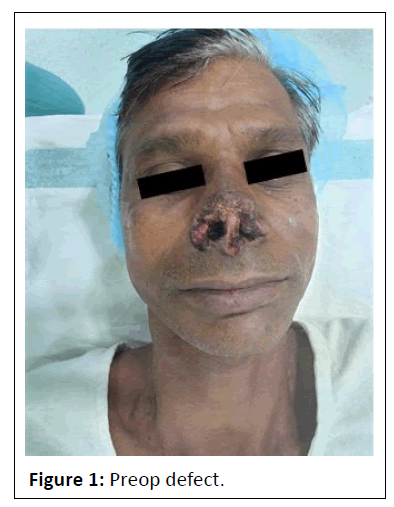Tagliaclozzi Flap as a "Life Boat" Surgery for Paramedian Forehead Flap (PFF) Failure
Kanishk Vishnoi*, Chaitanya Ramteke, Deepika B Garg and PS Nagpure
Department of Otorhinolaryngology and Head and Neck Surgery, Mahatma Gandhi Institute of Medical Sciences (MGIMS), Maharashtra, India
- *Corresponding Author:
- Kanishk Vishnoi
Department of Otorhinolaryngology and Head and Neck Surgery,
Mahatma Gandhi Institute of Medical Sciences (MGIMS),
Maharashtra,
India,
Tel: 7619064659;
E-mail: vishnoikanishk@gmail.com
Received date: December 01, 2022, Manuscript No. IPARS-22-15097; Editor assigned date: December 05, 2022, PreQC No. IPARS-22-15097 (PQ); Reviewed date: December 20, 2022, QC No. IPARS-22-15097; Revised date: March 20, 2023, Manuscript No. IPARS-22-15097 (R); Published date: March 27, 2023, DOI: 10.36648/2472-1905.9.3.044
Citation: Vishnoi K, Ramteke C, Garg DB, Nagpure PS (2023) Tagliaclozzi Flap as a “Life Boat” Surgery for Paramedian Forehead Flap (PFF) Failure. J Aesthet Reconstr Surg Vol:9 No:3
Abstract
Tagliaclozzi flap is a random pattern tubed pedicle flap harvested on the antero-medial surface of the arm, technique which developed in the 16th century. Developed by the Italian pioneer surgeon Gaspare Tagliaclozzi which according to some was based on the trade secrets of “Sushruta Samhita” which traveled to Italy via its Arabic translation in the 8th century and the “Italian methods of nasal reconstruction” were developed. This technique is revisited in the case described as the life boat for paramedian forehead flap failure.
Keywords
Tagliaclozzi flap; Nasal reconstruction; Life boat; Paramedian forehead flap; Tagliaclozzi
Introduction
This study describes a patient who was a unique case of human bite on the ala region during a fist fight and reconstruction was done by a standard paramedian forehead flap [1]. Patient was a cigarette smoker with upwards of 25 pack years, and nutritional status was not optimum [2]. Patient developed forehead flap necrosis within 5 days and the reconstruction was done with “Tagliaclozzi” flap on his left arm subsequently. In the second stage flap was divided and resuturing was done and conchal cartilage was placed in the tissue pocket. Third stage was debunking of the tissue and fine tuning of the flap.
Case Presentation
The Tagliaclozzi flap is a random pattern flap that has been used historically for nasal reconstruction [3]. This pedicle flap is based on the deltoid branches of the thoraco-acromial artery and re-currents from ulnar and radial artery and is considered to be the stepping stone for the advanced nasal reconstruction today (Figures 1-3). Decision of its preference over free flap (radial artery based) was taken based on many factors including smoking and economical aspect. Patient being an auto rickshaw driver was not willing for any advanced plastic surgery procedures. Necrosis of the forehead flap was another factor of the patient denying to give consent for the free flap (Figure 4). The immobilization procedure is one particular disadvantage of this flap which lead to stiffening of shoulder for this patient [4]. Advantage of this flap was the thin skin of the arm which was used to give scaffolding for the conchal cartilage which was being used to reconstruct the alar grove. The timing of reconstruction was also key for taking the decision to choose this flap as patient was not willing to extend the hospital stay more than a month [5]. Forehead flaps have a particular disadvantage of facial scarring which can be avoided by using this flap in cases where it suits (Figures 5 and 6).
Results and Discussion
The results of this surgery lead to psychosocial rehabilitation of the patient within his community [6]. Nasal disfigurement in particular is considered a big stigma in the Indian rural community and thus affects the quality of life of the patient which was the main factor for giving consent for multiple reconstructions. This study explained how such patient can be dealt with when the initial forehead flap fails (workhorse flap).
Conclusion
The result was satisfactory for the patient and the patient is able to rehabilitate in his community confidently. Author emphasis on the point that Tagliaclozzi flap although inferior to the free flap can be used in certain situations. This can be used in the case of chronic cigarette smokers where a chance of flap necrosis is high. With physiotherapy the complications of immobilizations can be managed. The time of reconstruction is markedly reduced using the Tagliaclozzi flap.
References
- Menick FJ (1990) Aesthetic refinements in use of forehead for nasal reconstruction: The paramedian forehead flap. Clin Plast Surg 17:607-622
[Crossref] [Google Scholar] [PubMed]
- Jellinek NJ, Nguyen TH, Albertini JG (2014) Paramedian forehead flap: Advances, procedural nuances, and variations in technique. Dermatol Surg 40:S30-42
[Crossref] [Google Scholar] [PubMed]
- Stigall LE, Bramlette TB, Zitelli JA, Brodland DG (2016) The paramidline forehead flap: A clinical and microanatomic study. Dermatol Surg 42:764-771
[Crossref] [Google Scholar] [PubMed]
- Chen CL, Most SP, Branham GH, Spataro EA (2019) Postoperative complications of paramedian forehead flap reconstruction. JAMA Facial Plast Surg 21:298-304
[Crossref] [Google Scholar] [PubMed]
- Burget GC, Walton RL (2007) Optimal use of microvascular free flaps, cartilage grafts, and a paramedian forehead flap for aesthetic reconstruction of the nose and adjacent facial units. Plast Reconstr Surg 120:1171-1207
[Crossref] [Google Scholar] [PubMed]
- Arden RL, Nawroz‐Danish M, Yoo GH, Meleca RJ, Burgio DL (1999) Nasal alar reconstruction: A critical analysis using melolabial island and paramedian forehead flaps. Laryngoscope 109:376-382
[Crossref] [Google Scholar] [PubMed]
Open Access Journals
- Aquaculture & Veterinary Science
- Chemistry & Chemical Sciences
- Clinical Sciences
- Engineering
- General Science
- Genetics & Molecular Biology
- Health Care & Nursing
- Immunology & Microbiology
- Materials Science
- Mathematics & Physics
- Medical Sciences
- Neurology & Psychiatry
- Oncology & Cancer Science
- Pharmaceutical Sciences






